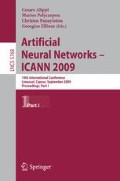Abstract
Continuous attractor neural network (CANN) models have been studied in conjunction with many diverse brain functions including local cortical processing, working memory, and spatial representation. There is good evidence for continuous stimuli, such as orientation, moving direction, and the spatial location of objects could be encoded as continuous attractors in neural networks. Although their wide applications for the information processing in the brain, representation and stability analysis of continuous attractors in non-linear recurrent neural networks (RNNs) have been reported very little so far. This paper studies the continuous attractors of Lotka-Volterra (LV) recurrent neural networks. Conditions are given to insure the network has continuous attractors. Representation of continuous attractor is obtained under the conditions. Simulations are employed to illustrate the theory.
Access this chapter
Tax calculation will be finalised at checkout
Purchases are for personal use only
Preview
Unable to display preview. Download preview PDF.
References
Amari, S.: Dynamics of pattern formation in lateral-inhibition type neural fields. Biological Cybernetics 27, 77–87 (1977)
Ben-Yishai, R., Bar-Or, R.L., Sompolinsky, H.: Theory of orientation tuning in visual cortex. Proc. Nat. Acad. Sci. USA 92, 3844–3848 (1995)
Compte, A., Brunel, N., Goldman-Rakic, P.S., Wang, X.J.: Synaptic mechanisms and network dynamics underlying spatial working memory in a cortical network model. Cereb. Cortex 10, 910–923 (2000)
Yu, J., Zhang, Y., Zhang, L.: Representation of continuous attractors of recurrent neural networks. IEEE Transactions on Neural Networks 20(2), 368–372 (2009)
Salinas, E.: Background synaptic activity as a switch between dynamical states in network. Neural computation 15, 1439–1475 (2003)
Seung, H.S.: How the brain keeps the eyes still. J. Neurobiology 93, 13339–13344 (1996)
Seung, H.S.: Continuous attractors and oculomotor control. Neural Networks 11, 1253–1258 (1998)
Seung, H.S.: Learning continuous attractors in recurrent networks. Adv. Neural Info. Proc. Syst. 10, 654–660 (1998)
Seung, H.S., Lee, D.D.: The manifold ways of perception. Science 290, 2268–2269 (2000)
Samsonovich, A., McNaughton, B.L.: Path integration and congnitive mapping in a continuous attractor neural network model. J. Neurosci. 7, 5900 (1997)
Stringer, S.M., Trppenberg, T.P., Rolls, E., Aranjo, I.: Self organizing continuous attractor networks and path integration: One-dimensional models of head direction cell. Network: Computation in Neural Systems 13, 217–242 (2002)
Trappenberg, T.P., Standage, D.I.: Self-organising continuous attractor networks with multiple activity packets, and the representation of space. Neural Networks 17, 5–27 (2004)
Tsodyks, M., Sejnowski, T.: Associative memory and hippocampal place cells. International journal of neural systems 6, 81–86 (1995)
Wu, S., Amari, S., Nakahara, H.: Population coding and decoding in a neural fields: a computational study. Neural Computation 14, 999–1026 (2002)
Wu, S.: Shun-Ichi Amari, Computing with continuous attractors: Stability and online aspects. Neural Computation 17, 2215–2239 (2005)
Wu, S., Hamaguchi, K., Amari, S.: Dynamics and computation of continuous attractors. Neural Computation 20, 994–1025 (2008)
Zhang, K.C.: Representation of spatial orientation by the intrinsic dynamics of the head-direction cell ensemble: A Theory. The journal of neuroscience 16(6), 2110–2126 (1996)
Author information
Authors and Affiliations
Editor information
Editors and Affiliations
Rights and permissions
Copyright information
© 2009 Springer-Verlag Berlin Heidelberg
About this paper
Cite this paper
Zhang, H., Yu, J., Yi, Z. (2009). Continuous Attractors of Lotka-Volterra Recurrent Neural Networks. In: Alippi, C., Polycarpou, M., Panayiotou, C., Ellinas, G. (eds) Artificial Neural Networks – ICANN 2009. ICANN 2009. Lecture Notes in Computer Science, vol 5768. Springer, Berlin, Heidelberg. https://doi.org/10.1007/978-3-642-04274-4_30
Download citation
DOI: https://doi.org/10.1007/978-3-642-04274-4_30
Publisher Name: Springer, Berlin, Heidelberg
Print ISBN: 978-3-642-04273-7
Online ISBN: 978-3-642-04274-4
eBook Packages: Computer ScienceComputer Science (R0)

